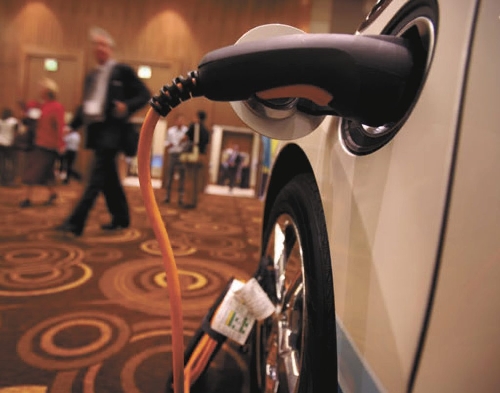Energy summit speakers plug going green

Big dreams.
They flowed fast and furious at Tuesday’s National Clean Energy Summit 4.0 at Aria, with a litany of speakers listing high-minded plans for greening the nation’s economy.
Take Vice President Joe Biden.
"Imagine what it would be like to be the first country to make solar power cheaper than coal. Imagine a city full of buildings able to produce all the energy they consume," Biden said. "Imagine by the end of the decade creating a car battery even lighter and cheaper than lithium-ion batteries today, a battery that can store enough to take you 300 miles on one charge."
And then there was this from Jim Murren, chairman and CEO of MGM Resorts International: "We want to re-imagine what this state could be. Can we make the hospitality capital of the world also the capital for innovative thinking in biotechnology and technology? Can we diversify our economy in a very special way?"
For now, those ideas remain, well, ideas. And speakers acknowledged that making them reality will require new federal policies and money, for which there is a shrinking appetite nationwide.
U.S. Energy Secretary Steven Chu noted that stimulus spending, a big source of funding for green initiatives since 2009, is winding down. Amid large deficits and hard times, some Washington policymakers argue the nation can’t afford more for clean energy, Chu said.
Biden also referred to "naysayers" who believe the economy is too "fragile" to finance green power incentives.
Plus, unlike the three prior summits, Tuesday’s speakers spent substantial time arguing for more federal involvement in the green economy. There were lots of references to the U.S. space program, military initiatives behind the Internet, the Transcontinental Railroad and land-grant schools established during the Civil War.
Their message?
"The government has played a key role in prosperity," Chu said. "We must not lose sight of that fact."
Not that the green economy hasn’t produced innovations. Tuesday morning, Enel Green Power North America announced that it is building a first-of-its-kind hybrid plant combining geothermal and solar power. The 24-megawatt plant is in Churchill County, near Reno.
The U.S. Green Building Council is applying its Leadership in Energy and Environmental Design (LEED) standards to 10,000 buildings in 129 countries worldwide, said Roger Platt, a senior vice president of the trade group.
Each day, the council certifies the energy-saving credentials of 1.5 million square-feet of buildings. That’s equivalent to an Empire State Building every week.
Platt pointed to LEED-certified CityCenter, where energy efficiency saves enough power to serve 8,000 homes.
Murren added that CityCenter recycles 33 percent of its waste, more than twice the state average for businesses.
On the manufacturing side, Chandra Brown, vice president of Oregon Iron Works, described how her Portland company has created new lines of business building electric cable cars and devices that capture ocean-wave energy for coastal communities.
There also has been progress in electric cars, said Jim Motavalli, a New York Times environmental reporter.
Nearly 15,000 Nissan Leafs and Chevy Volts have sold worldwide since 2010, and researchers are experimenting with using electric cars to return power to the grid, Motavalli said.
What’s more, solar-photovoltaic costs have plummeted 50 percent in recent years, with another 50 percent drop predicted in the next decade, Chu said.
"These technologies are no longer just curiosities," said Senate Majority Leader Harry Reid, D-Nev., the summit’s cosponsor. "They’re the tools and gadgets we will not be able to live without tomorrow. The future of energy is now."
Still, obstacles remain.
Expanding building efficiencies beyond a few thousand demonstration projects will require new tax incentives to "do the right thing," Platt said.
Also, ocean-wave energy is in a "very nascent stage right now," Brown said.
Electric cars? At $30,000 to $110,000, they remain out of reach for many Americans, Motavalli acknowledged. He said President Barack Obama’s goal of 1 million plug-in cars on U.S. roads is "very ambitious" and depends "on a lot of government regulations being instituted, and a lot of things going right."
A more achievable goal: 10 percent of U.S. cars electric by 2020, including hybrids, Motavalli said.
Greater advances in renewable energy will require more federal investment in research and development , Chu said. Also on his wish list: a federal clean energy development agency and a "sunshine program" akin to the 1960s space program.
Gov. Brian Sandoval, California Gov. Jerry Brown and Washington Gov. Christine Gregoire also called for more investment. Brown said it will take "billions and billions of dollars" to develop California’s renewable-energy sector.
Those wants could be tall orders in today’s political and economic climate, Biden said.
"I say that if we don’t make investments or set goals, we are going to lose," Biden said. "If we shrink from this, we will be making the biggest mistake the nation has made in its entire history."
Contact reporter Jennifer Robison at jrobison@reviewjournal.com or 702-380-4512.